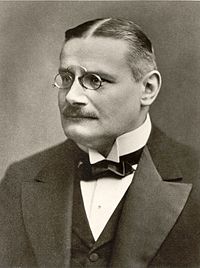Albert von Le Coq

Albert von Le Coq (German pronunciation: [albɛɐ̯t lə kok]; 8 September 1860 Berlin, Prussia – 21 April 1930 Berlin, Germany) was a Prussian/German brewery owner and wine merchant, who at the age of 40 began to study archaeology.[1]
Background
He was born at Berlin, of a family of French
Von Le Coq was heir to a sizable fortune derived from breweries and wineries scattered throughout Central and Eastern Europe, thus allowing him the luxury of travel and study at his leisure. The business he owned survives today as the A. Le Coq brewery in Tartu, Estonia.
Career as archaeologist
Aided by his wealth, von Le Coq became a famous

Von Le Coq was convinced that the influence of
Von Le Coq was associated with the Museum für Völkerkunde (now called the Ethnological Museum of Berlin) in Berlin. Serving as assistant to the head of the museum, Professor Albert Grünwedel, Le Coq helped plan and organize expeditions into the regions of western Asia, specifically areas near the Silk Road such as Gaochang. When Grünwedel fell ill before the departure of the second expedition, Le Coq was assigned to lead it. His account of the second and third German Turpan expeditions was published in English in 1928 as Buried Treasures of Chinese Turkestan.
The expeditions found extensive networks of
Le Coq said that the depictions of figures with apparently blue eyes, red hair and cruciform swords resembled Frankish art: "Such more striking are representations of red-haired, blue-eyed men with faces of a pronounced European type. We connect these people with the Aryan language found in these parts in so many manuscripts.. These red haired people wear suspenders from their belts.. a remarkable ethnological peculiarity!"[citation needed]
With the help of
Most of the manuscripts collection survived stored in salt mines. After the war the major part of the collection was given in 1946 to the newly founded Deutsche Akademie der Wissenschaften. A smaller portion found its way to the Mainzer Akademie der Wissenschaften und Literatur.
Notes
- ^ YLE TV 1 on 16 March 2014 with the title “The surprising finds of the Silk Road.”
- ^ von Le Coq, Albert. (1913). Chotscho: Facsimile-Wiedergaben der Wichtigeren Funde der Ersten Königlich Preussischen Expedition nach Turfan in Ost-Turkistan. Berlin: Dietrich Reimer (Ernst Vohsen), im Auftrage der Gernalverwaltung der Königlichen Museen aus Mitteln des Baessler-Institutes, Tafel 19. (Accessed 3 September 2016).
- ^ ISSN 2191-6411. See also endnote #32. (Accessed 3 September 2016.)
- ^ ISBN 978-0-19-993921-3.
- ^ von Le Coq, Albert. (1913). Chotscho: Facsimile-Wiedergaben der Wichtigeren Funde der Ersten Königlich Preussischen Expedition nach Turfan in Ost-Turkistan. Berlin: Dietrich Reimer (Ernst Vohsen), im Auftrage der Gernalverwaltung der Königlichen Museen aus Mitteln des Baessler-Institutes, p. 28, Tafel 20. (Accessed 3 September 2016).
- ^ a b Digby, T. (2002-05-09). "Nests of the Great Game spies". Shanghai Star. Archived from the original on 2011-06-11. Retrieved 2010-11-26.
- ^ From the Introduction by Peter Hopkirk in the 1985 edition of Von Le Coq's Buried Treasures of Chinese Turkestan, p. ix-x.
References and further reading
- von Le Coq, Albert (1928), Buried Treasures of Chinese Turkestan: An Account of the Activities and Adventures of the Second and Third German Turpan Expeditions, translated by Barwell, Anna, London: George Allen & Unwin (Repr: 1985, OUP. ISBN 0-19-583878-5)
- von Le Coq, Albert (1922), Die buddhistische Spätantike in Mittelasien, vol. 1: Die Plastik, Berlin: Dietrich Reimer
- von Le Coq, Albert (1923), Die buddhistische Spätantike in Mittelasien, vol. 2: Die Manichaeischen Miniaturen, Berlin: Dietrich Reimer
- von Le Coq, Albert (1924), Die buddhistische Spätantike in Mittelasien, vol. 3: Die Wandmalereien, Berlin: Dietrich Reimer
- von Le Coq, Albert (1924), Die buddhistische Spätantike in Mittelasien, vol. 4: Atlas zu den Wandmalereien, Berlin: Dietrich Reimer
- von Le Coq, Albert (1926), Die buddhistische Spätantike in Mittelasien, vol. 5: Neue Bildwerke, Berlin: Dietrich Reimer
- von Le Coq, Albert (1928), Die buddhistische Spätantike in Mittelasien, vol. 6: Neue Bildwerke II, Berlin: Dietrich Reimer
- von Le Coq, Albert (1933), Die buddhistische Spätantike in Mittelasien, vol. 7: Neue Bildwerke III, Berlin: Dietrich Reimer
- ISBN 0-87023-435-8
